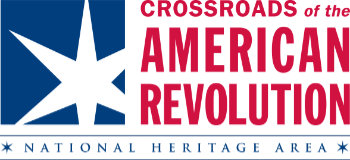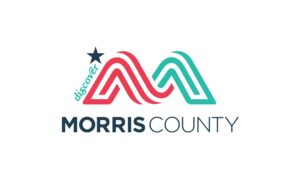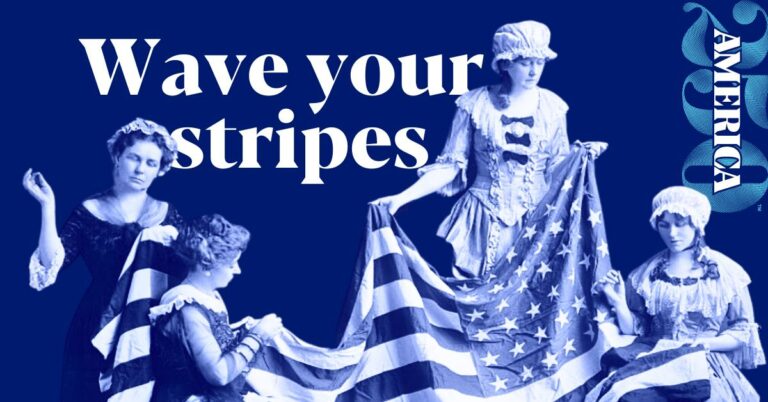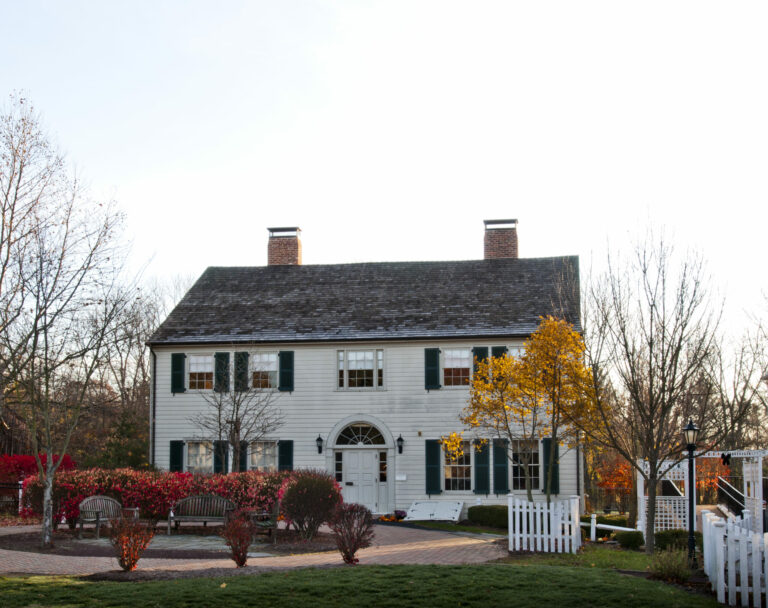Crossroads is grateful to the talented historians, narrators, musicians and photographers who help us bring the stories of New Jersey’s Revolutionary heritage to life through our audio tours. Learn more about them and the stories behind the soundtrack below.
Narration services by Vocalize This! Audio Productions
Historical recollections brought to life by:
Ian Burrow has been an archaeological and cultural resource management professional since 1975. In 2015 he founded BurrowIntoHistory, LLC, a company whose mission is to improve the preservation, management, and public enjoyment of historic cultural resources in the United States and beyond. He was the 2015 recipient of the New Jersey Historical Commission’s Richard J. Hughes Award for Distinguished Contributions to Public Knowledge and Preservation of New Jersey History. He has investigated numerous archaeological sites, including the Old Barracks National Historic Landmark in Trenton, the Pluckemin Artillery Cantonment in Somerset County, NJ, the Charles Carroll House in Annapolis, and Princeton Battlefield. He has also directed major investigations on 18th-century urban sites in Philadelphia, Trenton, and Jersey City. He has taught at Drew, Rutgers, Rider, and at the University of Delaware.
Old Barracks Museum historical interpreters:
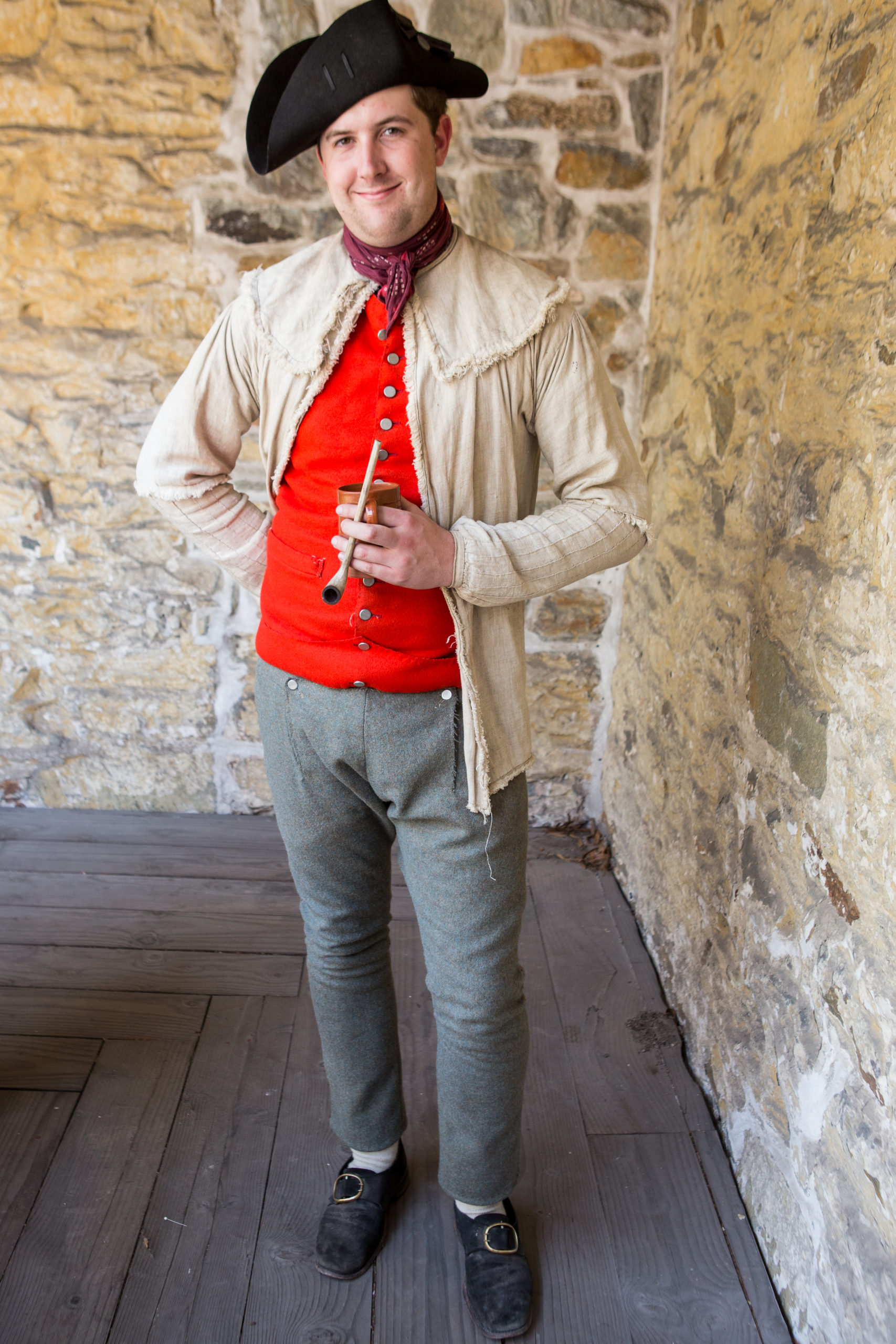 James Bevan got his start at the Old Barracks in their Fife and Drum program and later returned to the museum as a specialist in military interpretation. James served in the Army National Guard for eight years, was deployed once, and is currently attending classes at Thomas Edison State University to receive his Bachelors in History.
James Bevan got his start at the Old Barracks in their Fife and Drum program and later returned to the museum as a specialist in military interpretation. James served in the Army National Guard for eight years, was deployed once, and is currently attending classes at Thomas Edison State University to receive his Bachelors in History.
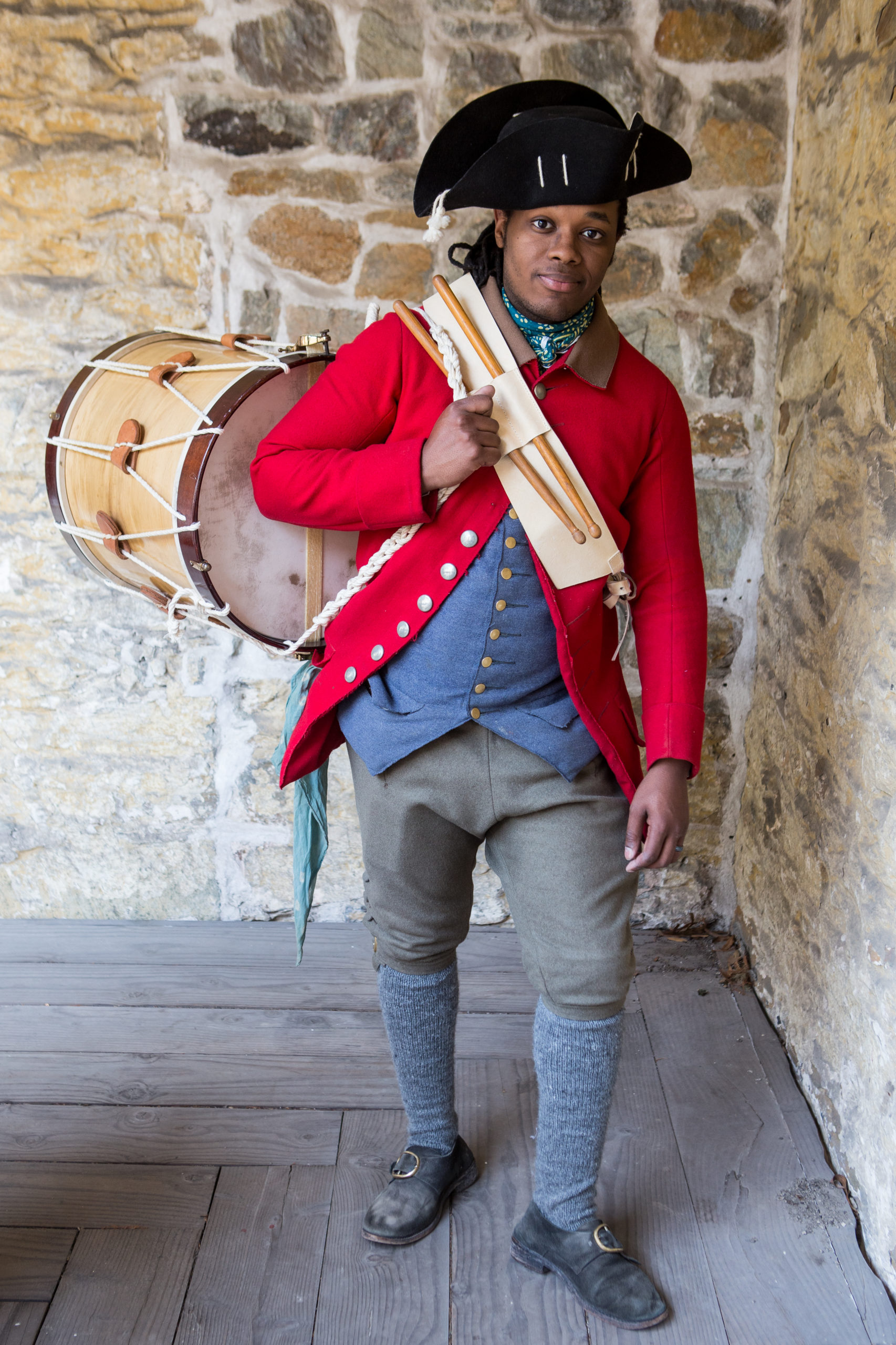 Daryian Kelton has been an interpreter for about 8 years. He started young at the Old Barracks Museum as a drummer in their Fife and Drum Corps. He has always been intrigued by the puzzles of history and how everyone’s stories fit together. In 2015, Daryian stepped into producing social media content by producing photos, videos and graphics. In addition, he has been an integral part of developing African American History programming for the museum.
Daryian Kelton has been an interpreter for about 8 years. He started young at the Old Barracks Museum as a drummer in their Fife and Drum Corps. He has always been intrigued by the puzzles of history and how everyone’s stories fit together. In 2015, Daryian stepped into producing social media content by producing photos, videos and graphics. In addition, he has been an integral part of developing African American History programming for the museum.
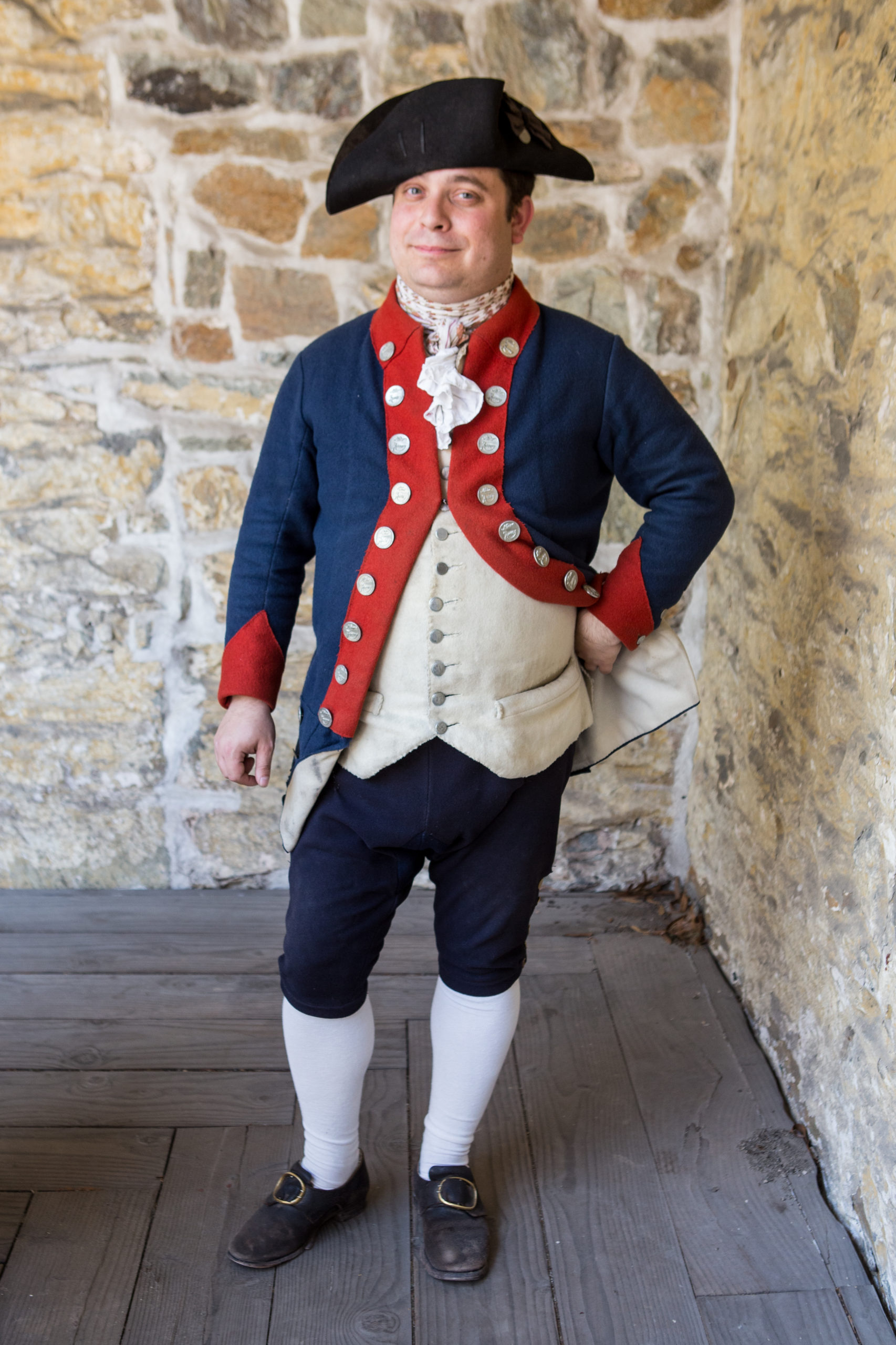 Asher Lurie is the Chief of Historical Interpretation at the Old Barracks Museum in Trenton, New Jersey. His area of expertise is the study of the British and American armies in the last two quarters of the 18th century. He has also studied Hessian accounts of the Battle of Trenton and the mythology that surrounds the battles of Trenton and Princeton.
Asher Lurie is the Chief of Historical Interpretation at the Old Barracks Museum in Trenton, New Jersey. His area of expertise is the study of the British and American armies in the last two quarters of the 18th century. He has also studied Hessian accounts of the Battle of Trenton and the mythology that surrounds the battles of Trenton and Princeton.
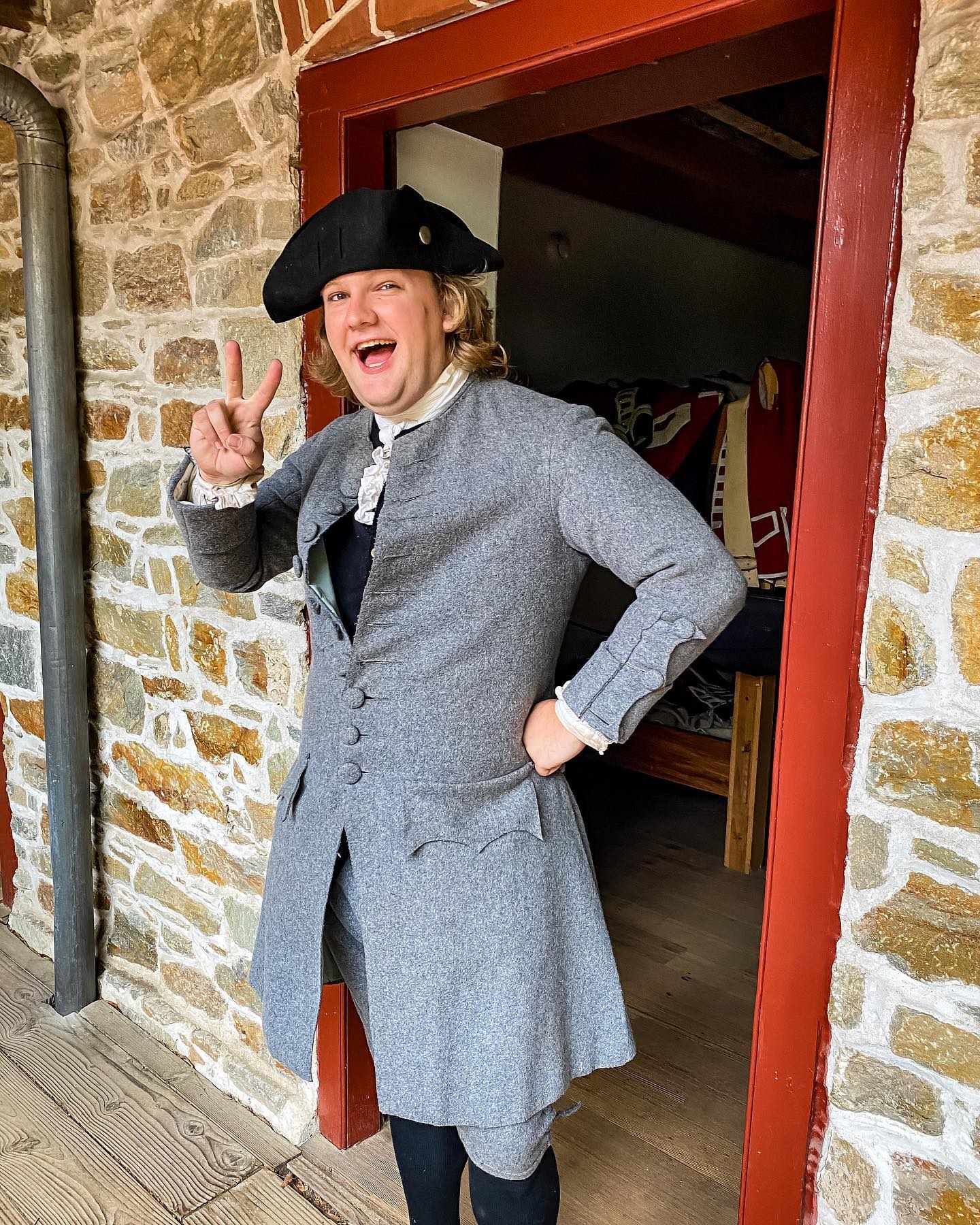 Damian Niescior is a historical interpreter who has been in the public history field since 2009. During which he has picked up skills in tailoring and shoemaking. After joining the museum in 2019, Damian manages and produces all the shoes for the Barracks staff. He is currently attending Rutgers University for a MS of Forensic Science.
Damian Niescior is a historical interpreter who has been in the public history field since 2009. During which he has picked up skills in tailoring and shoemaking. After joining the museum in 2019, Damian manages and produces all the shoes for the Barracks staff. He is currently attending Rutgers University for a MS of Forensic Science.
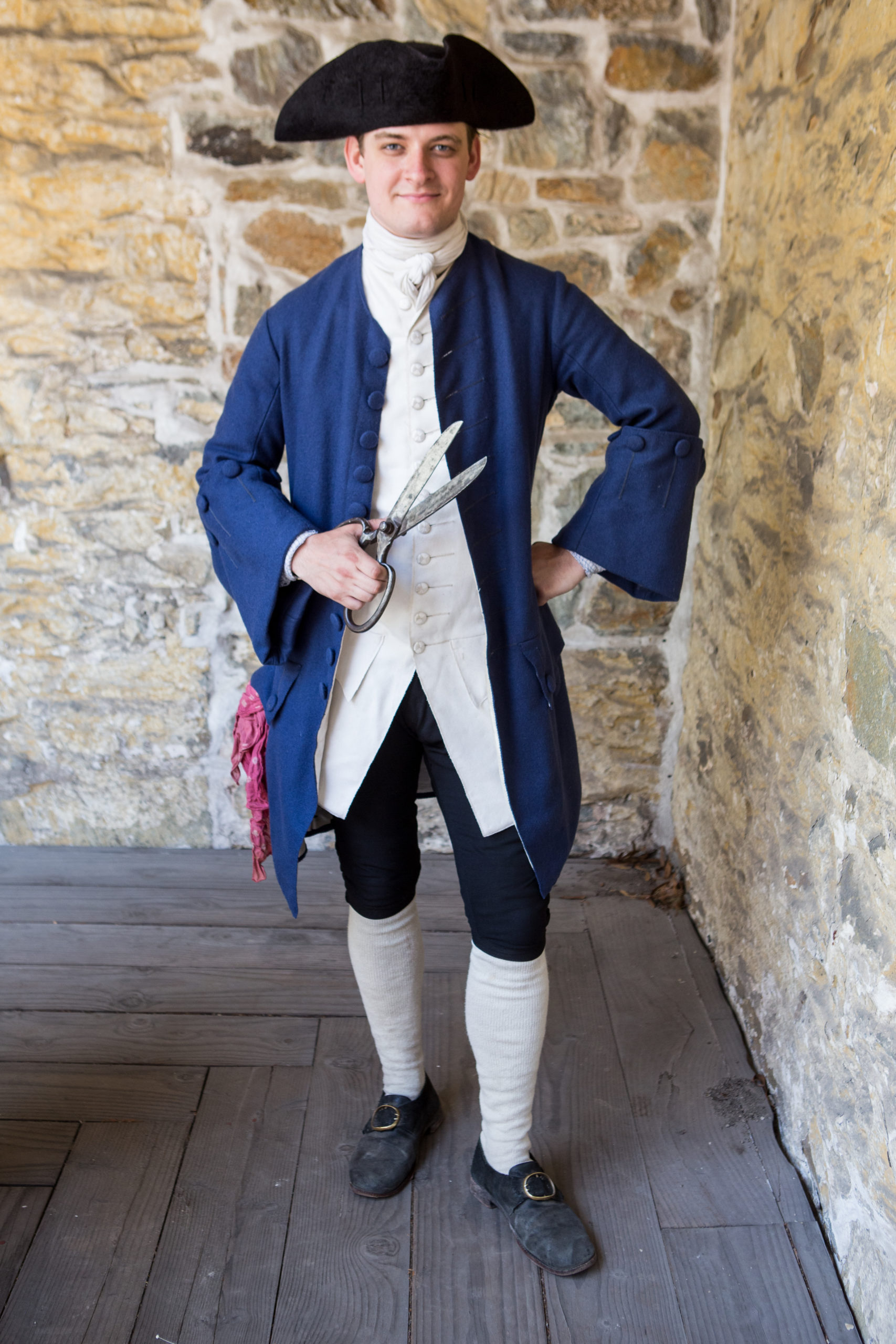 David Niescior has been at the Barracks since 2013, and works as an interpreter and tailor. He achieved his MA in American History at Rutgers in 2015 and studies the material culture of early America. Since 2020 he has studied Early American carpentry and joinery. David is an historical interpreter at the Old Barracks Museum.
David Niescior has been at the Barracks since 2013, and works as an interpreter and tailor. He achieved his MA in American History at Rutgers in 2015 and studies the material culture of early America. Since 2020 he has studied Early American carpentry and joinery. David is an historical interpreter at the Old Barracks Museum.
Photos found in the app are courtesy of Crossroads of the American Revolution image library, Washington Crossing Historic Park, the Library of Congress, and Meredith Barnes.
Molly Picture Studio photographer Meredith Barnes is a living history reenactor with Col. Ogden’s 1st NJ. 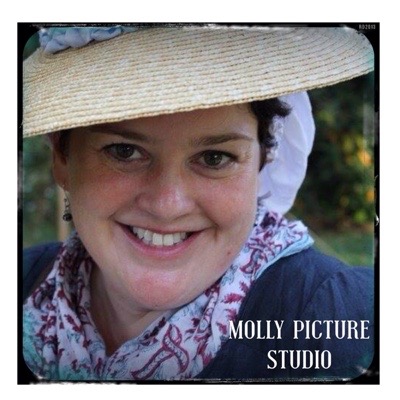 When not at a reenactment, Meredith is in public relations for New Jersey Education Association and is proud to work with the over 200,000 members who make New Jersey’s public schools number one in the nation. Meredith is also a world traveler and enjoys capturing wildlife, landscapes, architecture, and culture of her travel destinations. Find her photos on her website, Facebook, and Instagram.
When not at a reenactment, Meredith is in public relations for New Jersey Education Association and is proud to work with the over 200,000 members who make New Jersey’s public schools number one in the nation. Meredith is also a world traveler and enjoys capturing wildlife, landscapes, architecture, and culture of her travel destinations. Find her photos on her website, Facebook, and Instagram.
THE PRACTITIONERS OF MUSICK
About:
The Practitioners of Musick was founded to survey the musical riches of 17th and 18th century Great Britain and Ireland and the Colonial and Federal periods in America.
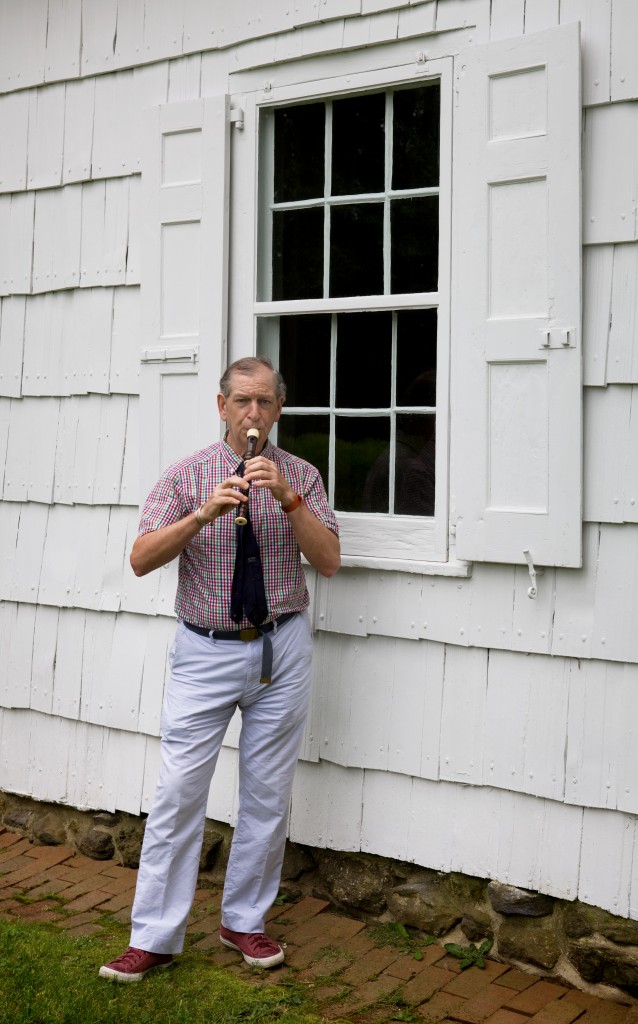 The Practitioners of Musick, John Burkhalter player of English & Small flutes and harpsichordist Donovan Klotzbeacher have presented or supported scholarly programs under the auspices of the National Park Service, The New Jersey Council for the Humanities, The National Trust of Great Britain, The Fund for Irish Studies at Princeton University, Historic Deerfield, Colonial Williamsburg, Metropolitan Museum of Art, The Princeton University Art Museum, The NY State Historical Association, The Holland Society of New York, the Yale Center for British Art, The Princeton University Library, the Monmouth County Historical Association, and The Museum of the American Revolution amongst many others.
The Practitioners of Musick, John Burkhalter player of English & Small flutes and harpsichordist Donovan Klotzbeacher have presented or supported scholarly programs under the auspices of the National Park Service, The New Jersey Council for the Humanities, The National Trust of Great Britain, The Fund for Irish Studies at Princeton University, Historic Deerfield, Colonial Williamsburg, Metropolitan Museum of Art, The Princeton University Art Museum, The NY State Historical Association, The Holland Society of New York, the Yale Center for British Art, The Princeton University Library, the Monmouth County Historical Association, and The Museum of the American Revolution amongst many others.
In America throughout the 18th century amateur music making was an accomplishment through which good manners, taste, and politeness could be displayed in the pursuit of refinement. The ability to play a musical instrument as well as sing, dance, and draw were important fashionable skills to be cultivated under the tutelage of professional music tutors, masters of the dance, and artists. Since music making was a collaborative endeavor bringing players and listeners together, it was thought to be an important way to convey the felicities of social harmony and this is the primary theme explored in Practitioners of Musick programming.
For additional information please visit The Practitioners’ website.
Musical Selections:
Stony Point
A very jaunty country social dance that commemorates the successful raid on Stony Point the British fortification on the west bank of the Hudson River under the command of Anthony Wayne on July 15th 1779. Washington as a result, secured cannon and a volume of stores that in his words “give our troops greater confidence in themselves and depress the spirits of the enemy proportionately.”
Cotillion
From The Beggar’s Opera of 1728 written by John Gay and known as the greatest theatrical work of the 18th century English playhouse. The play took a satirical look at politics and elite affectations and used recognizable tunes with new lyrics. The cotillion is a dance form that originated in France at the court of Louis XIV and eventually became popular in England.
It is documented that cotillions were taught by dancing masters who travelled to the various Atlantic maritime cities that were places of elite culture in Colonial America in the early 1770’s.
Country Dance 1774
It was a common practice for well established dancing masters in Britain to teach ladies and gentlemen fashionable dances such as the minuet as well as country dances during the “social season”. Accordingly, Music publishers were quick to bring in print, on an annual basis, publications that highlighted the most esteem’d dances for any given year and these in turn were announced for sale in broadsheet newspapers. Such dance collections were also widely available in 18th century America and used by itinerant dancing masters in such settings as The French Arms Tavern in Trenton or Mr. Whitehead’s “The Sign of the College” in Princetown.
Washington’s Country Dance
Everyone seemed to know how to do country dances, from rural folk to the gentry. The way they did them and setting might look different from barn yard to purpose built long room or ballroom, but the elements of the dance were the same. A country dance consisted of various figures such as hand-turns and circles, performed by dancers standing in longways sets: two lines, partners opposite each other. Washington is well known for his interest, ability, and deportment in the dance in pursuit of refinement. Given his august stature in the eyes of his countrymen it was natural for the General to be honored in myriad ways including dance.
Knyphausen’s March
This march honors Wilhelm von Knyphausen a nobleman and General who was a commander of German auxiliary or mercenary troops generally known as Hessians, as most came from the princely territory of Hesse-Kassel, during the Revolutionary War. Knyphausen saw action in the battles of White Plains in 1776, Brandywine in 1777, Monmouth in 1778, and many more. The march is taken from an important source of music in America from the last quarter of the 18th century compiled by Caspar Schaffner a professional musician in Lancaster, Pennsylvania. This manuscript (ca. 1790) seems to be the only known documented source for General Knyphausen’s march.
THE FIFES AND DRUMS OF THE OLD BARRACKS: GUARDIAN ANGELS CD, 2010
NEW JERSEY FIFES AND DRUMS
Learn more about the New Jersey Fifes & Drums and Old Barracks Fifes and Drums organizations.
Musical Selections:
La Réjouissance – “Rejoicing”
The rousing “La Réjouissance” or “The Rejoicing” is a taken from Music for the Royal Fireworks, a five movement orchestral suite composed by George Frideric Handel in 1749 for performance at an outdoor festival celebrating the end of the War of the Austrian Succession (1740–48). Its first performance preceded a fireworks display. The suite was originally scored for a military band of brass, oboes, bassoons, and various drums. Handel attached descriptive titles to the two central movements: the third movement is called “La Paix” (“The Peace”) in honor of the treaty itself, and the fourth is called “La Réjouissance” (“The Rejoicing”) to commemorate the mood of elation that followed. The rejoicing movement is so suitably martial in character that it seems quite appropriate to adapt it for a corps of fifes and drums.
“Come Haste to the Wedding” – A country dance
‘Come Haste to the Wedding’ is a lively jig tune in 6/8 of Gaelic origin. The earliest known source for the melody is James Oswald’s “Caledonian Pocket Companion” (London, 1759) a collection airs for unaccompanied German flute or violin with increasingly complex sets of variations. ‘Come Haste to the Wedding’ was famously introduced in a theatrical work called The Elopement of 1767 in a setting for two sopranos with a concluding chorus.
Chester
No song of patriotism was more sung during the Revolution than “Chester”. Both text and music written by Boston’s sturdiest musical patriot William Billings, an ardent friend of Samuel Adams and Paul Revere. With an opening text “Let tyrants shake their iron rod”….”We fear them not” the entire strophic song was no doubt fervently sung by soldiers, Continentals and militia alike, around encampment fires and the melody adapted and played by “American” fifers from New England to the South.
General Washington’s March
Various marches bear the name of Washington or refer to him. General Washington’s March is included in an important source of music in America from the last quarter of the 18th century, a manuscript compiled ca. 1790 by Caspar Schaffner the leading professional musician in Lancaster, Pennsylvania. Schaffner’s transcription of the music honoring General Washington seems to be a very early documented source for march. It has been suggested that the march was originally composed by Philip Phile (Pfeil) a Hessian musician attached to Knyphausen’s Regiment captured at Trenton in 1776.
Yankee Doodle / British Grenadiers
Along with Chester, Yankee Doodle was at the core of revolutionary sentiment and resonated loudly and clearly throughout the former American Colonies that had become independent in Philadelphia on July 4th 1776. Yankee Doodle quickly became the Continental Army’s signal march. Francis Hopkinson one of New Jersey’s FIVE Signers of the Declaration of independence famously appropriated the tune in his song setting of “The Battle of the Kegs” a neat example of propaganda published in the Pennsylvania Packet, March 4, 1778 and tells the launching of primed powder kegs – mines – against British ships moored in the Delaware River a few miles above Philadelphia.
It has been originally thought that the source of the music for the eponymous British Grenadiers is an edition of john Playford’s Dancing Master (ca. 1690) where the tune appears as “The New Bath”. Another possible source for the melody is related to a Dutch march introduced into Britain during the reign of WilIiam III who was also Prince of Orange of the House of Nassau. NB: There is the Dutch link with the College of New Jersey and Nassau Hall in “Princetown”. The first known association of the tune with the regiment of “Redcoats” is in 1706 as “The Granadeer’s March”. And the first version with lyrics about the year 1750. Before American Independence the song was parodied in Boston in response to the British occupation of the city. During the Revolutionary War the crack regiment famously marched to the stirring military music on the battlefield at Brandywine in September of 1777.
Thanks to our partner sites for their help with script narratives, primary sources, and first-person accounts used throughout this tour.
- Washington Crossing Historic Park
- Washington Crossing State Park
- Washington Crossing Park Association, NJ
- Old Barracks Museum
- Princeton Battlefield
- Princeton Battlefield Society
- Morven Museum & Garden
Special thanks to Larry Kidder for his work on developing the script and research for this tour. His recent book, Ten Crucial Days, was published by Knox Press in 2020.
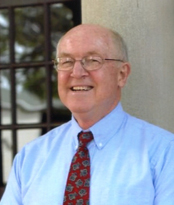 William “Larry” Kidder was born in California and raised in California, Indiana, New York, and New Jersey. He received his bachelor’s and master’s degrees from Allegheny College. A US Navy veteran, with service in Vietnam, he considers teaching to be both his vocation and avocation, continuing in retirement after having taught for forty years in public and private schools. For thirty years, Larry has been a volunteer historian, interpreter, and draft horse teamster for Howell Living History Farm. He is active in central New Jersey historical societies and is an avid member of the Association for Living History, Farm, and Agricultural Museums (ALHFAM), the Washington’s Crossing Roundtable of the American Revolution, the New Jersey Living History Advisory Council, and the Advisory Council for Crossroads of the American Revolution. The Ten Crucial Days tour was created by Crossroads of the American Revolution National Heritage Area. It was made possible by the generous support of the National Park Service, the George A. Ohl Jr. Trust, the F.M. Kirby Foundation, Friends of Washington Crossing Park, Pennsylvania and Visit Bucks County.
William “Larry” Kidder was born in California and raised in California, Indiana, New York, and New Jersey. He received his bachelor’s and master’s degrees from Allegheny College. A US Navy veteran, with service in Vietnam, he considers teaching to be both his vocation and avocation, continuing in retirement after having taught for forty years in public and private schools. For thirty years, Larry has been a volunteer historian, interpreter, and draft horse teamster for Howell Living History Farm. He is active in central New Jersey historical societies and is an avid member of the Association for Living History, Farm, and Agricultural Museums (ALHFAM), the Washington’s Crossing Roundtable of the American Revolution, the New Jersey Living History Advisory Council, and the Advisory Council for Crossroads of the American Revolution. The Ten Crucial Days tour was created by Crossroads of the American Revolution National Heritage Area. It was made possible by the generous support of the National Park Service, the George A. Ohl Jr. Trust, the F.M. Kirby Foundation, Friends of Washington Crossing Park, Pennsylvania and Visit Bucks County.
Narration services by Vocalize This! Audio Productions
Thanks to our partner sites for their help with script narratives, primary sources, and first-person accounts used throughout this tour.
More Information Coming Soon
Special thanks to Stephen Elliott for his work on developing the script and research for this tour. His first book, Surviving the Winters: Housing Washington’s Army during the American Revolution was published in 2021 by the University of Oklahoma Press.
Steven Elliott holds a PhD in History from Temple University. His research has been recognized by awards and fellowships from the David Library of the American Revolution, George Washington’s Mount Vernon, the Society of the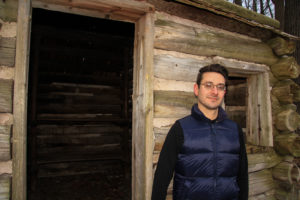 Cincinnati, the Heritage Trail Association, and the New Jersey Historical Commission. Reviews have described the book as “demand[ing] we rethink the course of the American Revolutionary War” and an “essential read for anyone studying the Revolutionary War.”
Cincinnati, the Heritage Trail Association, and the New Jersey Historical Commission. Reviews have described the book as “demand[ing] we rethink the course of the American Revolutionary War” and an “essential read for anyone studying the Revolutionary War.”
Steven has also published articles and reviews in New Jersey Studies, The Journal of the Early Republic, and The Journal of Military History. He currently works as a unit historian for the United States Army Center of Military History, where he is writing an official history of the Trenton and Princeton Campaign. Additionally, he teaches online courses on local history at Rutgers University-Newark and previously, worked as a park guide and volunteer at Morristown National Historical Park from 2009 to 2017. He is currently researching an article on the US Army during the Quasi-War with France, 1798-1800. The Washington Slept Here tour was created by Crossroads of the American Revolution National Heritage Area. It was made possible by the generous support of the National Park Service, the National Park Foundation, the George A. Ohl Jr. Trust, the F.M. Kirby Foundation, the Hampshire Companies, LLC, and the Morris County Tourism Bureau.
